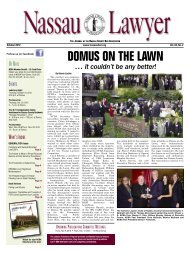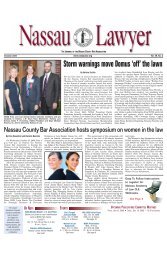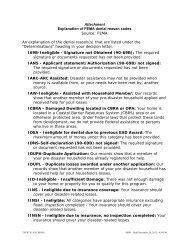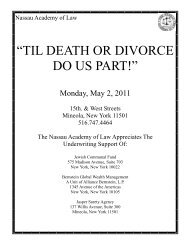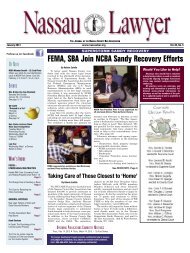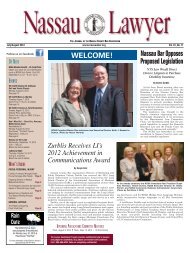302 B.R. 760 Page 12302 B.R. 760(Cite as: 302 B.R. 760)district court concluded that the management'sembezzlement <strong>of</strong> surplus funds raisedthrough artificially inflated stock sales wasnot a "reasonably foreseeable" result <strong>of</strong> theoverstated financial statements:It is arguably foreseeable, as a result <strong>of</strong> financialstatements overstating the financialcondition <strong>of</strong> a corporation, that securities issuedand sold by that corporation will commanda price higher than their true value,that purchasers will be injured as a resultand that the corporation will receive excessivefunds in consideration for the securities.However, it is certainly not a direct or reasonablyforeseeable result <strong>of</strong> such financialstatements that inside management will embezzlesuch surplus funds for their personaluse.Id. at 540. Whatever the merits <strong>of</strong> that conclusionin the context <strong>of</strong> publicly-tradedcorporation, it is <strong>of</strong> limited relevance in thiscase.*774 That State Street actually suspected the Spitzes'embezzlement--even before the D & B Reports confirmedthat Sharp was overstating its accounts receivable--isnot a matter a speculation. The complaintspecifically alleges that on November 6, 1998, Benninger,the loan workout specialist assisting in theinvestigation <strong>of</strong> Sharp pulled copies <strong>of</strong> Sharp checksthat had passed through State Street's demand depositaccount for the purpose <strong>of</strong> determining, inter alia,whether Sharp had made substantial payments to theSpitzes. See Compl. 45. Benninger made anothersuch inquiry, approximately two weeks later. See id.These allegations undercut the notion that State Streetmight only have suspected that Sharp was a failingbusiness. Of course, as discussed above, suspicions<strong>of</strong> the Spitzes' fraud, without more, would at bestsupport an inference <strong>of</strong> constructive knowledge.However, State Street is alleged to have acquiredsufficient evidence <strong>of</strong> the Spitzes' fraud to bring itbeyond the realm <strong>of</strong> mere suspicion and surmise.In sum, contrary to the Bankruptcy Court's conclusion,Sharp has plead sufficient facts which if provencould lead a reasonable jury to infer that State Street,a sophisticated commercial bank, actually knew--atleast as <strong>of</strong> mid-November 1998--<strong>of</strong> a unitary fraud atSharp, consisting <strong>of</strong> the fraudulent reporting <strong>of</strong> thecompany's accounts receivable in order to raisemoney to fund the looting <strong>of</strong> the corporation by corruptmanagement.Participation[10][11][12][13] The "knowing participation" element<strong>of</strong> the aiding and abetting claim requires morethan a defendant's knowledge <strong>of</strong> the primary violation.To state a claim, a plaintiff must allege someform <strong>of</strong> participation by the alleged aider and abetterin the primary wrongdoing. Broadly speaking, thecase law identifies two forms <strong>of</strong> actionable "participation."First, aiding and abetting liability can attachwhere a defendant provides substantial assistance tothe primary wrongdoer. "One provides substantialassistance if he affirmatively assists, helps conceal, orby virtue <strong>of</strong> failing to act when required to do so enablesa [breach <strong>of</strong> fiduciary duty] to proceed."Kolbeck, 939 F.Supp. at 247. In general, inaction--e.g., a failure to investigate or to alert third partiesabout another's misconduct--does not constitute substantialassistance, unless the defendant owes a specialduty directly to the plaintiff. "It is well settledthat without an independent duty to disclose, mereinaction does not amount to substantial assistance forpurposes <strong>of</strong> determining aider and abettor liability."Calcutti v. SBU, Inc., 273 F.Supp.2d 488, 494(S.D.N.Y.2003) (citing National Westminster BankUSA v. Weksel, 124 A.D.2d 144, 511 N.Y.S.2d 626(1st Dep't 1987)). The existence <strong>of</strong> the primary violator'sduty is not sufficient to hold a non-fiduciarysecondary actor liable for inaction on an aiding andabetting theory.[14] Second, even without directly assisting in thecommission <strong>of</strong> the underlying *775 wrong, a defendantmay still be liable as an aider and abetter for"inducing" or "encouraging" a fiduciary to breach hisduties to another. See Kaufman, 760 N.Y.S.2d at 169(holding that a claim for aiding and abetting a breach<strong>of</strong> fiduciary duty requires, inter alia, allegations thatthe defendant knowingly induced or participated inthe breach) (emphasis added); Wight v. BankamericaCorp., 219 F.3d 79, 91 (2d Cir.2000) (same); S & KSales Co. v. Nike, 816 F.2d 843, 849 (2d Cir.1987).The Restatement (Second) <strong>of</strong> Torts explains that"[a]dvice or encouragement to act," in instanceswhere "the act encouraged is known to be tortious[,]... has the same effect upon the liability <strong>of</strong> the advisoras participation or physical assistance." Restatement(Second) <strong>of</strong> Torts § 876, comment "d"; see also© 2009 Thomson Reuters. No Claim to Orig. US Gov. Works.
302 B.R. 760 Page 13302 B.R. 760(Cite as: 302 B.R. 760)Lindsay v. Lockwood, 163 Misc.2d 228, 233, 625N.Y.S.2d 393, 397 (Sup.Ct. Monroe Co.1994) ("Thearchetypical aiding and abetting defendant is one whoencourages another to commit a tortious act.").[15] In this case, Sharp contends that upon discoveringthe scheme in November 1998, State Street demandedthat Sharp obtain new financing to retire itsdebt to State Street--financing which could only beobtained by expanding the scope <strong>of</strong> the fraud on theNoteholders, and which led to an infusion <strong>of</strong> freshmoney to fund the Sptizes' continued looting. Sharpfurther asserts that State Street affirmatively assistedthe expanded fraud in three respects: first, instead <strong>of</strong>immediately foreclosing, [FN6] State Street providedSharp with continued access to the line <strong>of</strong> credit toenable the Spitzes to find new innocent investors;second, one <strong>of</strong> State Street's employees deliberatelyavoided phone calls from the Noteholders' representative,who he knew would be calling to inquire aboutthe Sharp credit; and third, State Street provided writtenconsent to Sharp's sale <strong>of</strong> $25 million in subordinatednotes to the Noteholders, without which thedeal could not have gone forward, since, under theterms <strong>of</strong> Sharp's agreements with State Street, Sharpcould not take on additional debt without StateStreet's consent.FN6. The complaint alleges that Sharp'sCredit Agreement with State Street providedfor a demand line <strong>of</strong> credit, see Compl. 16,and, therefore, State Street had an absoluteright to repayment upon demand at any time.State Street counters that Sharp's allegations are ultimatelybased on "inaction," viz. that State Street didnot demand immediate repayment, did not respond toinquiries from the Noteholders or otherwise revealthe evidence <strong>of</strong> fraud it discovered, and did not interferewith Sharp's raising <strong>of</strong> new funds. Such inaction,State Street reasons, cannot constitute substantialassistance because State Street was not a fiduciary <strong>of</strong>(and, therefore, owed no special duty to) Sharp or itsother creditors. [FN7] See *776Manufacturers HanoverTrust Co. v. Yanakas, 7 F.3d 310, 318 (2dCir.1993) ("[T]he mere fact that a corporation hasborrowed money from the same bank for severalyears is insufficient to transform the relationship intoone in which the bank is a fiduciary.") (cited in ADTOperations, Inc. v. Chase Manhattan Bank, N.A., 173Misc.2d 959, 662 N.Y.S.2d 190, 193(Sup.Ct.N.Y.Co.1997)); Bank Leumi Trust Co. <strong>of</strong>N.Y. v. Block 3102 Corp., 180 A.D.2d 588, 580N.Y.S.2d 299, 301 (1st Dep't 1992) ("The legal relationshipbetween a borrower and a bank is a contractualone <strong>of</strong> debtor and creditor and does not create afiduciary relationship between the bank and its borrower....").FN7. State Street is correct that the law imposesno affirmative duty on a bank to actwhen it learns that its borrower is committinga fraud since one does not wish to discouragelenders from conducting investigations<strong>of</strong> their borrowers. On the other hand,as a matter <strong>of</strong> public policy such a dutymight be desirable to prevent the compounding<strong>of</strong> losses at least in those situationswhere the lender knows that by its consentto the refinancing, a looting scheme will befurthered. If State Street's discovery <strong>of</strong> thelooting did give rise to a duty to act-eitherby somehow reporting the fraud, or at thevery least demanding immediate repaymentthescope <strong>of</strong> the looting would have been farsmaller than it ultimately became. Indeed, asa result <strong>of</strong> the Spitzes' expanded fraud, theNoteholders negligent as they undoubtedlywere in carrying out their due diligence werecheated out <strong>of</strong> an additional $25 million,while Sharp (and by extension its creditors)suffered a further loss <strong>of</strong> $19 million in divertedfunds. However, despite these considerations,the law is clear that a lender isnot a fiduciary <strong>of</strong> a borrower, and has noduty to act simply because it suspects oreven knows <strong>of</strong> a fraud perpetuated by theborrower's management.The conflicting policy considerations discussedabove are also reflected in the criminallaw, but the result may well be the opposite.Assuming that the bank <strong>of</strong>ficials hadactual knowledge that the Spitzes were intendingto loot the Noteholders' monies thatwere not being used to satisfy Sharp's debtto State Street and that they were told thiswas the only way the bank would ever getits money back, they might well be criminallyliable as aiders and abettors under 18U.S.C. § 2(a). See Sand et al., Modern JuryFederal Jury Instructions [Criminal] Vol. 1,Chapter 11, Aiding and Abetting Instruction11-2, pp. 11-3-4© 2009 Thomson Reuters. No Claim to Orig. US Gov. Works.
- Page 1 and 2:
Nassau Academy of LawCLE Live Class
- Page 3 and 4:
McKinney's Debtor and Creditor Law
- Page 5 and 6:
McKinney's Debtor and Creditor Law
- Page 7 and 8:
McKinney's Debtor and Creditor Law
- Page 9 and 10:
McKinney's Debtor and Creditor Law
- Page 11 and 12: McKinney's Debtor and Creditor Law
- Page 13 and 14: McKinney's Debtor and Creditor Law
- Page 15 and 16: McKinney's Debtor and Creditor Law
- Page 17 and 18: McKinney's Debtor and Creditor Law
- Page 19 and 20: BAKER & HOSTETLER LLP45 Rockefeller
- Page 21 and 22: usiness of defendant Bernard L. Mad
- Page 23 and 24: BACKGROUND, THE TRUSTEE, AND STANDI
- Page 25 and 26: Madoff who received fraudulent tran
- Page 27 and 28: ased on fictitious profits and for
- Page 29 and 30: 28. BLMIS funds were also used to p
- Page 31 and 32: Madoff, and her niece, Shana Madoff
- Page 33 and 34: 42. Ruth Madoff was never an employ
- Page 35 and 36: FIRST CAUSE OF ACTIONTURNOVER AND A
- Page 37 and 38: 66. At the time of each of the Two-
- Page 39 and 40: Transfers; (b) directing that the S
- Page 41 and 42: EIGHTH CAUSE OF ACTIONUNDISCOVERED
- Page 43 and 44: TENTH CAUSE OF ACTIONDISALLOWANCE O
- Page 45 and 46: 111. Mrs. Madoff benefited from the
- Page 47 and 48: WHEREFORE, the Trustee respectfully
- Page 49 and 50: 2(c)(3): (a) preserving the Subsequ
- Page 51 and 52: 302 B.R. 760 Page 1302 B.R. 760(Cit
- Page 53 and 54: 302 B.R. 760 Page 3302 B.R. 760(Cit
- Page 55 and 56: 302 B.R. 760 Page 5302 B.R. 760(Cit
- Page 57 and 58: 302 B.R. 760 Page 7302 B.R. 760(Cit
- Page 59 and 60: 302 B.R. 760 Page 9302 B.R. 760(Cit
- Page 61: 302 B.R. 760 Page 11302 B.R. 760(Ci
- Page 65 and 66: 302 B.R. 760 Page 15302 B.R. 760(Ci
- Page 67 and 68: 302 B.R. 760 Page 17302 B.R. 760(Ci
- Page 69 and 70: 302 B.R. 760 Page 19302 B.R. 760(Ci
- Page 71 and 72: 394 B.R. 721 Page 1394 B.R. 721, 50
- Page 73 and 74: 394 B.R. 721 Page 3394 B.R. 721, 50
- Page 75 and 76: 394 B.R. 721 Page 5394 B.R. 721, 50
- Page 77 and 78: 394 B.R. 721 Page 7394 B.R. 721, 50
- Page 79 and 80: 394 B.R. 721 Page 9394 B.R. 721, 50
- Page 81 and 82: 394 B.R. 721 Page 11394 B.R. 721, 5
- Page 83 and 84: 394 B.R. 721 Page 13394 B.R. 721, 5
- Page 85 and 86: 394 B.R. 721 Page 15394 B.R. 721, 5
- Page 87 and 88: 394 B.R. 721 Page 17394 B.R. 721, 5
- Page 89 and 90: 394 B.R. 721 Page 19394 B.R. 721, 5
- Page 91 and 92: 394 B.R. 721 Page 21394 B.R. 721, 5
- Page 93 and 94: 397 B.R. 642 Page 2397 B.R. 642(Cit
- Page 95 and 96: 397 B.R. 642 Page 4397 B.R. 642(Cit
- Page 97 and 98: 397 B.R. 642 Page 6397 B.R. 642(Cit
- Page 99 and 100: 397 B.R. 642 Page 8397 B.R. 642(Cit
- Page 101 and 102: 397 B.R. 642 Page 10397 B.R. 642(Ci
- Page 103 and 104: 397 B.R. 642 Page 12397 B.R. 642(Ci
- Page 105 and 106: 397 B.R. 642 Page 14397 B.R. 642(Ci
- Page 107 and 108: 443 F.3d 180 Page 2443 F.3d 180(Cit
- Page 109 and 110: 443 F.3d 180 Page 4443 F.3d 180(Cit
- Page 111 and 112: 443 F.3d 180 Page 6443 F.3d 180(Cit
- Page 113 and 114:
443 F.3d 180 Page 8443 F.3d 180(Cit
- Page 115 and 116:
443 F.3d 180 Page 10443 F.3d 180(Ci
- Page 117 and 118:
443 F.3d 180 Page 12443 F.3d 180(Ci
- Page 119 and 120:
Page 2257 A.D.2d 526, 684 N.Y.S.2d
- Page 121 and 122:
Page 4257 A.D.2d 526, 684 N.Y.S.2d
- Page 123 and 124:
Page 6257 A.D.2d 526, 684 N.Y.S.2d
- Page 125 and 126:
770 N.Y.S.2d 421 Page 22 A.D.3d 780
- Page 127 and 128:
Page 14 A.D.3d 495, 773 N.Y.S.2d 71
- Page 129:
Page 34 A.D.3d 495, 773 N.Y.S.2d 71
- Page 132 and 133:
780 N.Y.S.2d 409 Page 29 A.D.3d 553
- Page 134 and 135:
Page 134 A.D.3d 231, 824 N.Y.S.2d 3
- Page 136 and 137:
Page 334 A.D.3d 231, 824 N.Y.S.2d 3
- Page 138 and 139:
Page 2991 F.2d 31(Cite as: 991 F.2d
- Page 140 and 141:
Page 4991 F.2d 31(Cite as: 991 F.2d
- Page 142 and 143:
Page 6991 F.2d 31(Cite as: 991 F.2d
- Page 144 and 145:
FRAUDULENT TRANFERENCESRonald M. Te
- Page 146 and 147:
Nursing home case_ Transfer of pers
- Page 148 and 149:
Sections 548 and 544 work in concer
- Page 150 and 151:
U.S. Supreme CourtBFP v. Resolution
- Page 152 and 153:
example, from net 15 to COD; or cha
- Page 154 and 155:
Bankruptcy Code Section§ 548. Frau
- Page 156:
Ron Terenzi is a founding partner a



